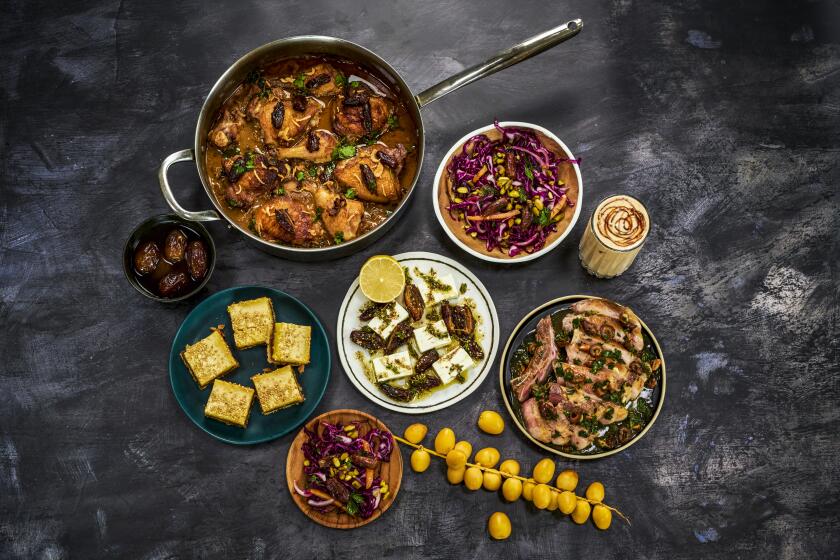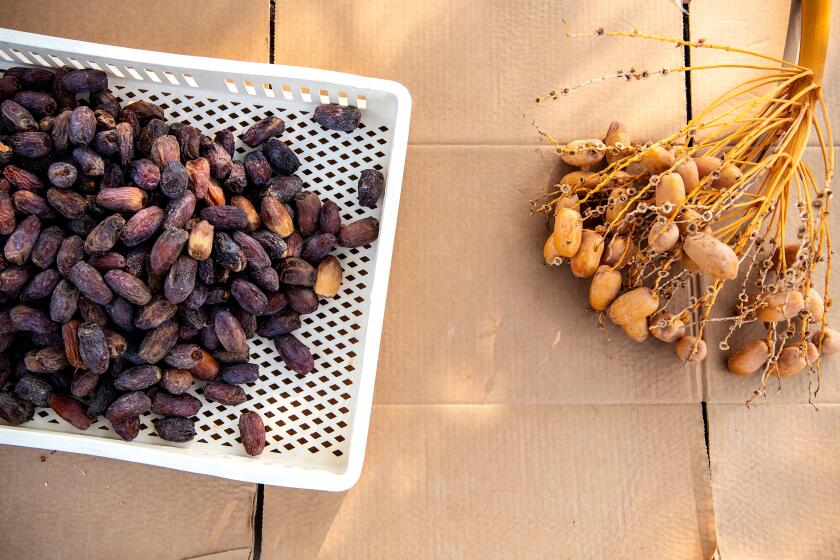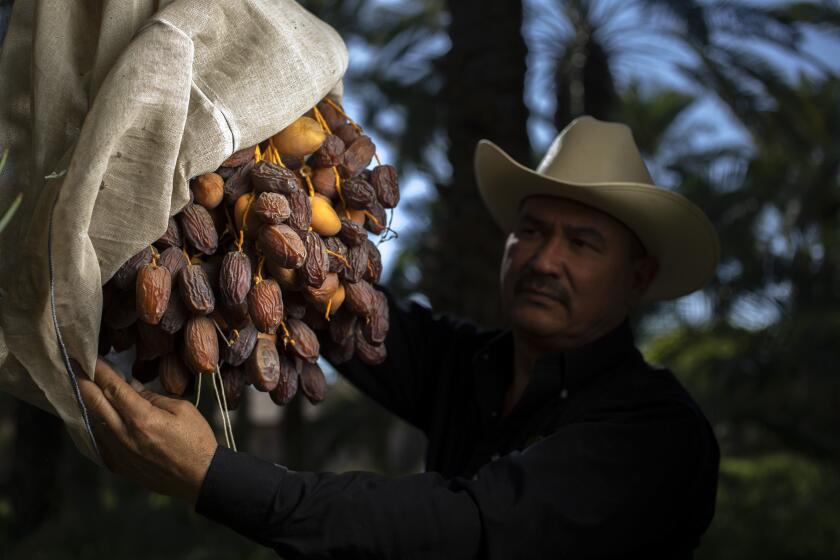You need to eat dates in the Coachella Valley right now
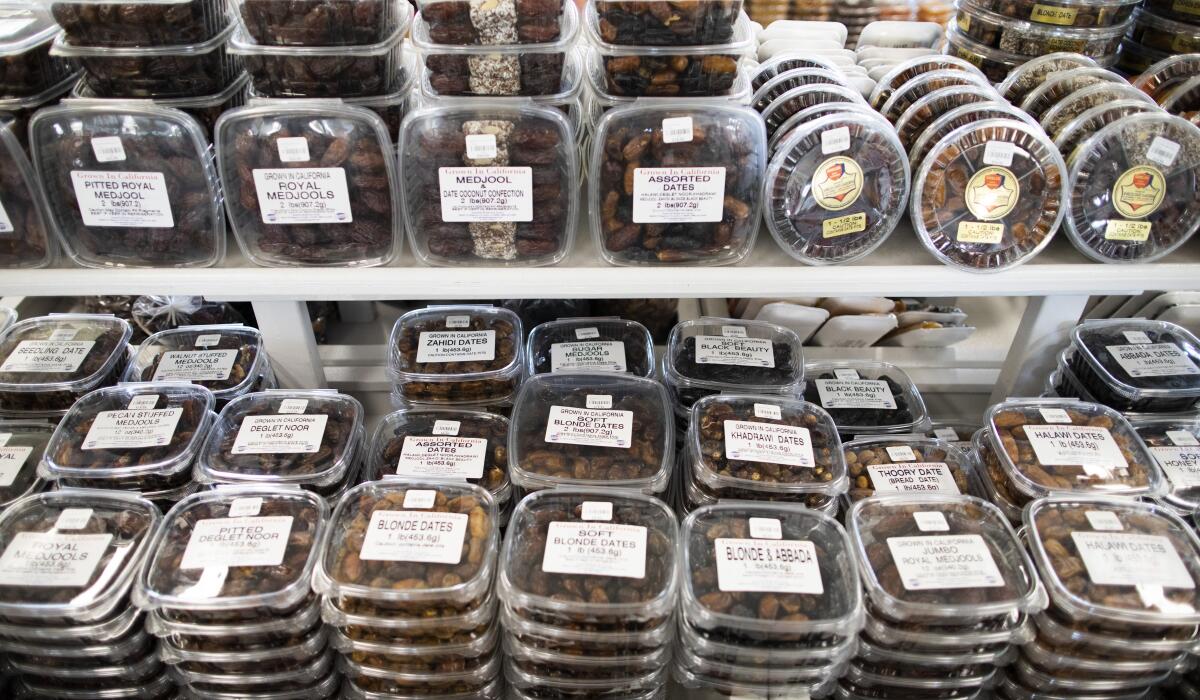
- Share via
Before all the windmill tours, pool parties and bangle-wearing festival-goers arrived, the wickedly dry and strikingly beautiful Coachella Valley caught the eye of a very different type of visitor: pioneers and farmers who envisioned acres and acres lined with date palms.
They did not arrive in the valley on a whim. At the end of the 19th century, the Department of Agriculture started a program staffed with men who traveled the world to look for new crops to bring back to the United States. Botanists traveled to the Middle East and North Africa to study date growing and concluded the dry, arid lands of the Coachella Valley might be the perfect place to foster date palms. Commercial groves were established a few years later.
“Dates are the coming profitable crop of California fruits,” George Wharton James, a Coachella Valley grower and historian, noted in a 1912 pamphlet on date culture. “Somebody is going to make a lot of money during the next few years out of dates. WHY NOT SECURE YOUR SHARE?”
Date cultivation predates the history books, but the date palm appears to be indigenous to the Middle East. In her book “The Date Palm: Bread of the Desert,” Hilda Simon writes about an ancient Islamic tale in which Adam buried clippings of his hair and fingernails in the ground and, “immediately, there sprang up from that spot in the garden [of Eden] a fully grown palm tree, heavy with clusters of ripe and delicious dates.” To this day, the fruit continues to play an important role in Islamic culture and cuisine. Dates are also extensively grown in North Africa, where date palm offshoots (the “children” or new sprouts that shoot off the main tree) were first purchased and transported to the Coachella Valley more than 100 years ago.
Smooth, sweet shakes, tart lemon bars, crunchy slaw and an aromatic chicken braise — these are just a few of the wonderful recipes utilizing the unique sweetness of dates.
Despite this rich history and tradition, dates seem to be underappreciated in the United States. But anyone who has experienced the caramel flair of the Halawy, the nutty-sweet Zahidi or the soft and chewy, honey-like qualities of the Medjool knows better.
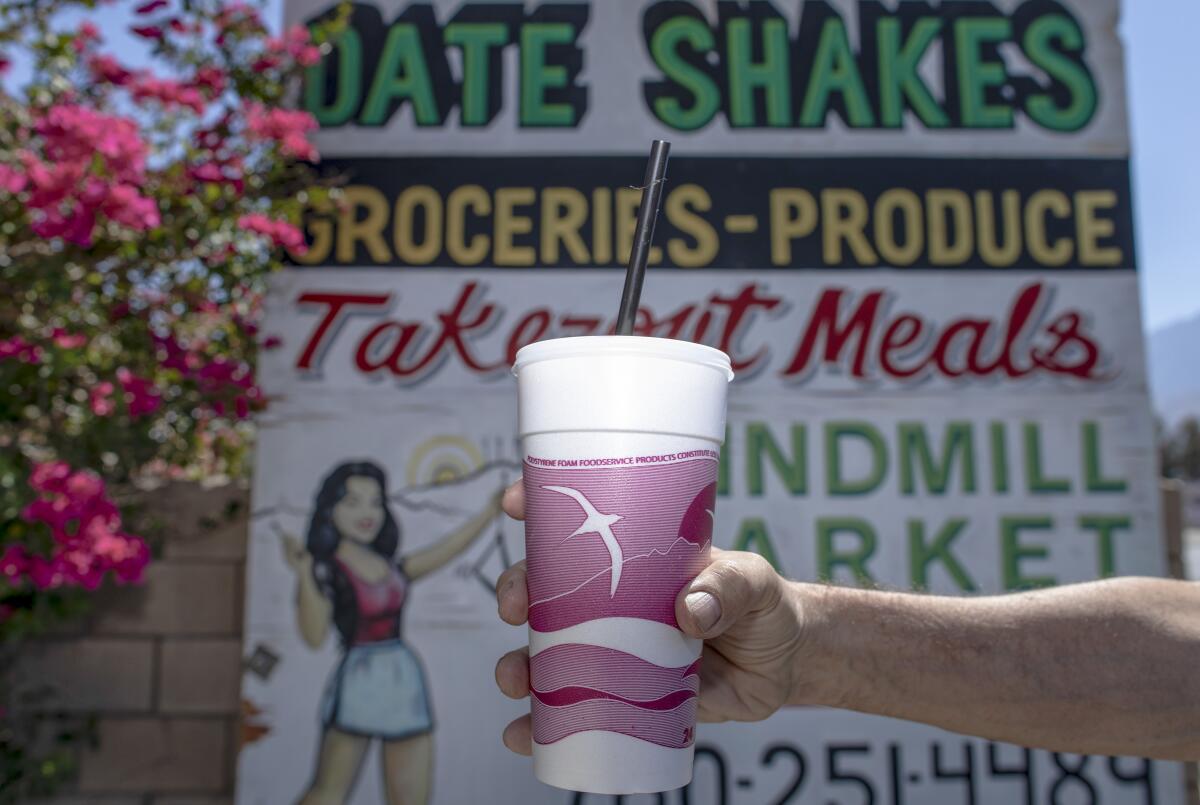
The meaty firm texture of a date like the Deglet Noor makes them perfect for stews and braises. In salads, some dates can offer a contrasting crunch in a bowl of delicate greens; other, softer varieties go well in an already crunchy slaw. Some dates are great — as is — for snacks or paired with cheese. Dates can transform lemon bars — and do we even need to remind you of the comforting qualities of date shakes?
Their distinctive flavors and stories provide a timeline that stretches for thousands of years — but you can make the trip to the Coachella Valley in just a couple of hours.
::
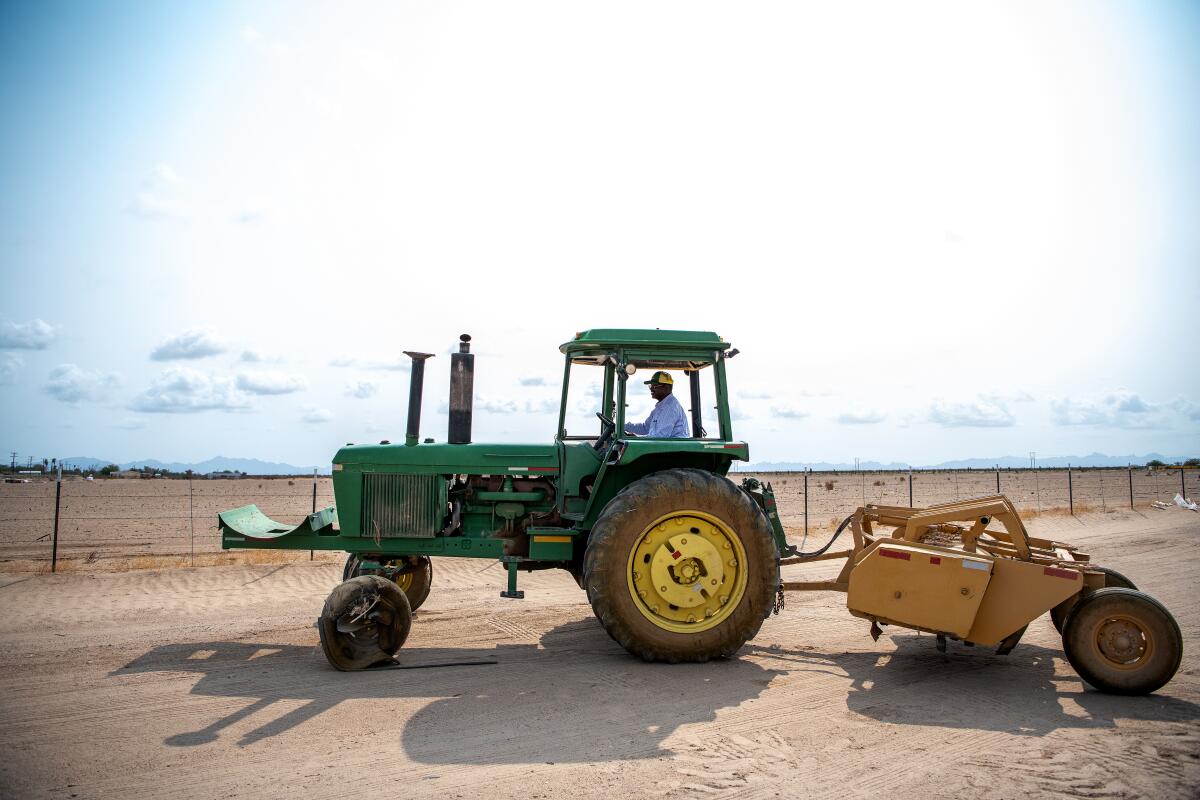
California grows 90% percent of all dates in the United States and most of them come from the Coachella Valley. According to the Agriculture Marketing Resource Center, in 2020, the Golden State produced 49,300 tons of dates (from 12,500 acres), and the crop was valued at $114 million.
Sam Cobb, who grows some of those dates at his farms in Desert Hot Springs and Blythe, Calif., says he can trace his first memory of eating a date — a Deglet Noor — to a Christmas during his childhood. Cobb, 59, initially didn’t like them, but after several tastes he concluded, “Hey, these are pretty good.”
He grew up in the Fresno area and says he knew at the age of 3 that he “was born to be a farmer,” adding, “like Superman, the green crystal [of farming] was calling.” In 1982 he started farming everything from radishes to watermelons. After a few years he went to work at the U.S. Department of Agriculture. Eventually, he moved his family to La Quinta, and in 2002 he decided to get back into farming, but this time around it would be dates. To this day, he says he’s “perhaps the only Black date farmer in California.”
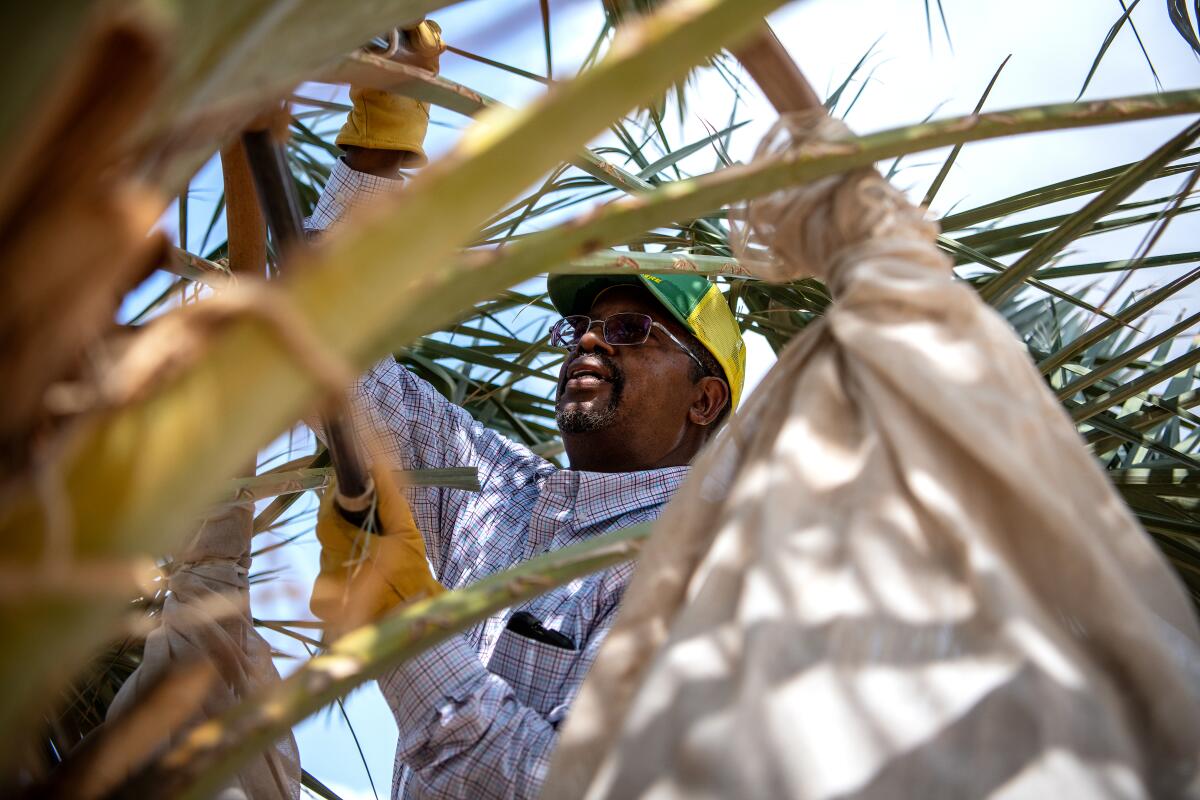
On a sweltering afternoon in July, Cobb was comparing his previous farming ventures to the dates he grows now: “It takes 21 days to grow a radish, and it takes 21 years for a date palm to grow [to maturity].” Growing dates, it seems, is a long-term commitment.
He operates a seasonal weekend market in Desert Hot Springs, selling his freshly picked dates starting in October. In addition to growing date palms for fruit, Cobb, like many date palm farmers, sells them as ornamental palm trees. A lucrative side hustle, they can go for about $2,000 a tree.
::
Dates may be sweet and versatile and the date shakes may slake your thirst, but all that deliciousness gives no hint of the work required for cultivation.
Farmers almost always grow new date palms from offshoots that develop from buds at the base of the mother plant. Starting from seed just takes too long, and using the offshoot ensures a certain uniformity of produce.
We can help you figure out how to use dates — in almost everything.
But the fruit doesn’t show up right away. It can take several years for a bud to develop with roots of its own and grow large enough to separate it from the mother plant. And those newly planted offshoots and the mother palms require year-round attention — and water. Cobb estimates that “each mature date palm needs about 2 acre-inches of water per year to produce a crop of dates, which comes out to 54,300 gallons of water per tree, per year.” (Some farms rely on flooding; others, like Woodspur Farms, the largest organic date farm in the U.S., are embracing drip irrigation.)
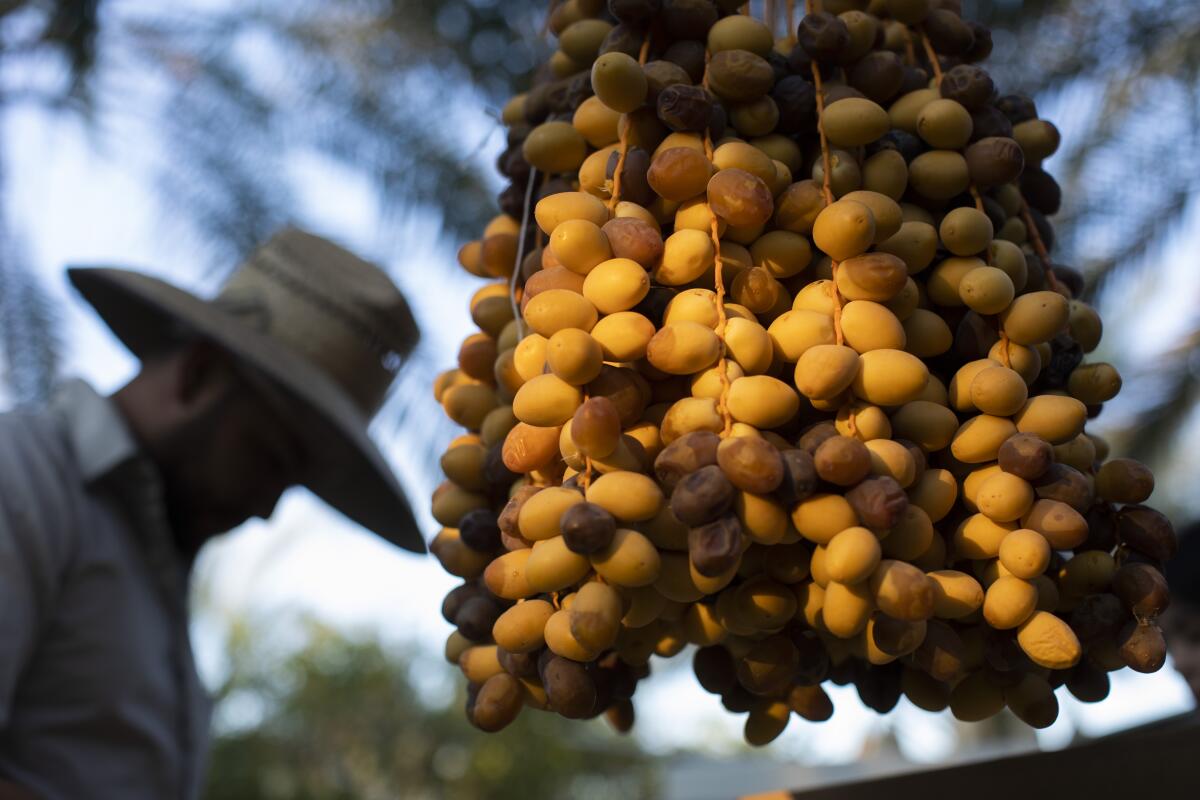
Depending on the variety and the health of the tree, a well-watered date palm can grow as high as 75 to 100 feet; they can economically produce fruit for about 40 to 50 years and can live for 120 to 150 years. In the middle of the summer before they are harvested, dates are already very appealing to birds and bugs, and farmers have to bag the growing fruit clusters.
Your guide to becoming a date expert.
Date aficionados sometimes like to talk about the sex life of date palms, although the springtime pollination process — sometimes done by hand — probably doesn’t seem particularly glamorous for the workers who are high in the air, maneuvering fronds to dust pollen from one tree onto the flowers of another. Date palms are dioecious, meaning that trees are either male or female — females are treated with pollen from the male plants. After pollination, dates — small and green at first — start to grow until they reach maturity. Harvest typically occurs from late August through October.
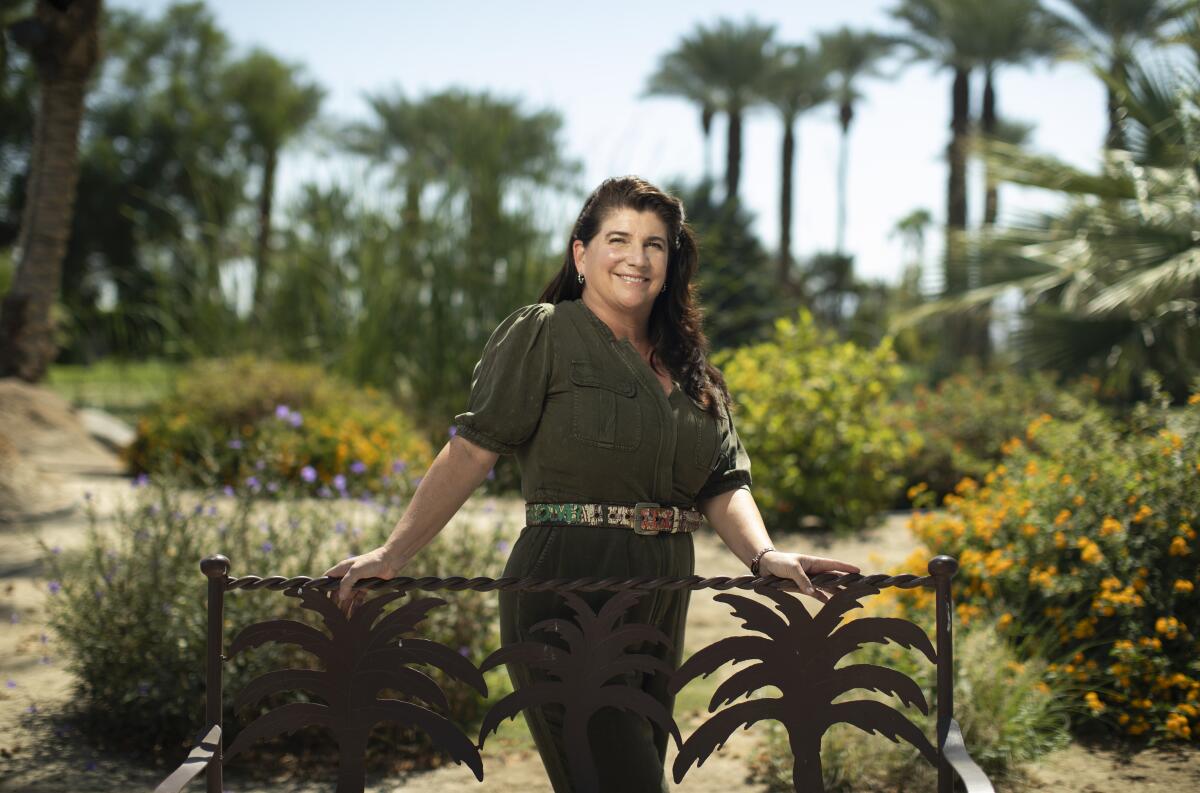
Some farmers sell onsite; others opt for online sales and farmers markets — or all three. Joan Smith of Rancho Meladuco, located at the north end of the Salton Sea, sells from a bricks-and-mortar store in Newport Beach.
The family’s dates are praised by chefs and customers across Southern California.
Not all date palms, of course, are created equal, and farmers, understandably, have strong opinions about their produce. Robert Lower of Flying Disc Ranch in Thermal, Calif., runs a biodynamic farm. His groves are rare among small producers because his date palms intermingle with hundreds of trees growing citrus, pomegranate, fig, avocado and other fruit . He prefers Barhi dates to the ubiquitous Medjools (although he grows both — and other varieties).
Lower has 500 Barhi date palms and says they could be the future of the date industry.
“I never really liked [growing] Medjools. I felt they were overrated,” Lower says. “They grow fast, but the Barhi produces twice as much.”
Do they taste like butterscotch? Coconut? This is the time of year to find out— and a trip to the Coachella Valley or the farmers market might answer that question.
More to Read
Eat your way across L.A.
Get our weekly Tasting Notes newsletter for reviews, news and more.
You may occasionally receive promotional content from the Los Angeles Times.
